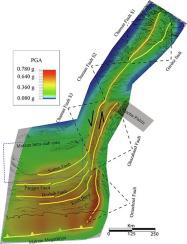当前位置:
X-MOL 学术
›
J. Asian Earth Sci.
›
论文详情
Our official English website, www.x-mol.net, welcomes your
feedback! (Note: you will need to create a separate account there.)
Fault-based probabilistic seismic hazard assessment of the eastern Makran subduction and the Chaman transform fault, Pakistan: Emphasis on the source characterization of megathrust
Journal of Asian Earth Sciences ( IF 2.7 ) Pub Date : 2021-01-01 , DOI: 10.1016/j.jseaes.2020.104604 Syed Tanvir Shah , A. Arda Özacar , Zeynep Gülerce
Journal of Asian Earth Sciences ( IF 2.7 ) Pub Date : 2021-01-01 , DOI: 10.1016/j.jseaes.2020.104604 Syed Tanvir Shah , A. Arda Özacar , Zeynep Gülerce

|
Abstract Seismic source characterization (SSC) for probabilistic seismic hazard assessment (PSHA) in regions characterized by subduction megathrust involves a considerable ambiguity. Lack of detailed geologic, seismic, and geodetic data increases the uncertainties. The enigma is enhanced in regions where thin-skinned accretionary prism faults are part of active deformation. In this study, a planar SSC model for seismically active eastern Makran subduction zone, its associated accretionary prism faults and Chaman transform fault zone is proposed based on a kinematic block model accounting strain partitioning. Sensitivity tests for various parameters of the SSC model are performed by computing peak ground acceleration (PGA) maps for 475-year return period. Among alternative magnitude distribution models, the truncated exponential model gives ∼10% higher PGA values than the composite recurrence model, which is favored by the observed subduction seismicity. Especially in gently dipping subduction zones such as Makran, estimated PGA values and their spatial distribution are highly sensitive (changing up to 0.3g) to the megathrust interface geometry near the surface, dip amount, and defined depth limits. Gentler and deeper extending subduction interface maximizes the rupture width and results in higher PGA values towards inland, while the inclusion of shallow aseismic portion produces larger PGA values near the trench. Through eastward transition from subduction to transform motion, thrust faults within the Makran accretionary prism bend northward, forming oblique fault systems with higher slip rates and accommodate part of the compression in accordance with the lateral slip rate variations identified on the Chaman transform fault zone. Using the selected SSC model, the PGA values for short return period (475-year) are estimated to be between 0.5g and 0.7g within the accretionary prism down to the trench across the Makran subduction and along southern section of Chaman transform fault zone where slip rates are higher relative to the north.
中文翻译:

基于断层的巴基斯坦东部 Makran 俯冲和查曼转换断层的概率地震危险性评估:强调巨型逆冲断层的震源特征
摘要 在以俯冲超逆冲为特征的地区,用于概率地震危险性评估 (PSHA) 的地震源表征 (SSC) 涉及相当大的模糊性。缺乏详细的地质、地震和大地测量数据会增加不确定性。在薄皮增生棱柱断层是活动变形的一部分的地区,这个谜团得到了加强。在这项研究中,基于考虑应变划分的运动学块模型,提出了地震活动的东部 Makran 俯冲带、其相关的增生棱柱断层和 Chaman 转换断层带的平面 SSC 模型。SSC 模型的各种参数的敏感性测试是通过计算 475 年重现期的峰值地面加速度 (PGA) 地图来执行的。在替代幅度分布模型中,截断指数模型给出的 PGA 值比复合递归模型高约 10%,这有利于观察到的俯冲地震活动。尤其是在 Makran 等缓倾俯冲带中,估计的 PGA 值及其空间分布对地表附近的大推力界面几何形状、倾角量和定义的深度限制高度敏感(变化高达 0.3g)。更温和和更深延伸的俯冲界面使破裂宽度最大化,并导致向内陆产生更高的 PGA 值,而浅层抗震部分的包含在沟槽附近产生更大的 PGA 值。通过从俯冲运动向东过渡,Makran增生棱柱内的逆冲断层向北弯曲,形成具有更高滑动速率的斜断层系统,并根据查曼变换断层带上识别的横向滑动速率变化来适应部分压缩。使用选定的 SSC 模型,估计在增生棱柱内的短重现期(475 年)的 PGA 值在 0.5 到 0.7 克之间,一直到穿过 Makran 俯冲带和沿查曼转换断层带南段的海沟,其中相对于北方,滑移率更高。
更新日期:2021-01-01
中文翻译:

基于断层的巴基斯坦东部 Makran 俯冲和查曼转换断层的概率地震危险性评估:强调巨型逆冲断层的震源特征
摘要 在以俯冲超逆冲为特征的地区,用于概率地震危险性评估 (PSHA) 的地震源表征 (SSC) 涉及相当大的模糊性。缺乏详细的地质、地震和大地测量数据会增加不确定性。在薄皮增生棱柱断层是活动变形的一部分的地区,这个谜团得到了加强。在这项研究中,基于考虑应变划分的运动学块模型,提出了地震活动的东部 Makran 俯冲带、其相关的增生棱柱断层和 Chaman 转换断层带的平面 SSC 模型。SSC 模型的各种参数的敏感性测试是通过计算 475 年重现期的峰值地面加速度 (PGA) 地图来执行的。在替代幅度分布模型中,截断指数模型给出的 PGA 值比复合递归模型高约 10%,这有利于观察到的俯冲地震活动。尤其是在 Makran 等缓倾俯冲带中,估计的 PGA 值及其空间分布对地表附近的大推力界面几何形状、倾角量和定义的深度限制高度敏感(变化高达 0.3g)。更温和和更深延伸的俯冲界面使破裂宽度最大化,并导致向内陆产生更高的 PGA 值,而浅层抗震部分的包含在沟槽附近产生更大的 PGA 值。通过从俯冲运动向东过渡,Makran增生棱柱内的逆冲断层向北弯曲,形成具有更高滑动速率的斜断层系统,并根据查曼变换断层带上识别的横向滑动速率变化来适应部分压缩。使用选定的 SSC 模型,估计在增生棱柱内的短重现期(475 年)的 PGA 值在 0.5 到 0.7 克之间,一直到穿过 Makran 俯冲带和沿查曼转换断层带南段的海沟,其中相对于北方,滑移率更高。









































 京公网安备 11010802027423号
京公网安备 11010802027423号